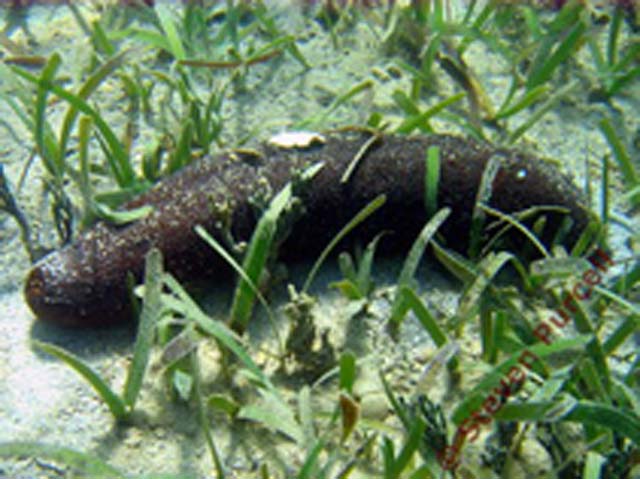| Holothuriidae (sea cucumbers) |
| 38 cm TL (male/unsexed); max.weight: 1,200.0 g |
|
reef-associated; marine; depth range 5 - 30 m |
| Western Central Pacific: New Caledonia, Palau and Micronesia. |
|
Mean live weight 700 to 1,200 g; body thickness 0.5 cm. Body elongate, cylindrical, slightly arched dorsally (bivium) and flattened ventrally (trivium). Bivium generally covered by fine sediment. Papillae on bivium small, slender, and conical; cylindrical and thick podia on trivium arranged irregularly on the radii and interradii; calcareous disc of podia around 700 micrometer in diameter. Mouth ventral, surrounded by 20 stout tentacles. Anus sub dorsal, surrounded by 5 strong, triangular, and nodose anal teeth. Calcareous ring thick, with large radial pieces and narrow interradials. Cuvierian tubules absent. Bivium black; trivium dark brown. Spicules sparse in the ventral and dorsal tegument, abundant only near the mouth, anus, and tentacles; a few rods in the dorsal tegument give rise to numerous rosettes, rods, and various plates; small to large plates provided with holes and spines near the anus; tentacles with rods straight or arched, bearing small spines. |
| May be collected by divers for artisanal fisheries along with other "blackfish" species, but not intensively so, since it is found in comparatively low densities and has deeper distribution. Processed product is not distinguished from those of other Actinopyga species; probably has a moderate commercial value. Found in moderately shallow water; on the lagoon floor, sometimes burrowed in sandy-muddy sediments (Ref. 122). Also on sandy reef flats and protected fine sand lagoons and bays (Ref. 92930). Populations reach medium densities up to 0.1 per square meter. A poorly known species (Ref. 122). |
|
(LC); Date assessed: 18 May 2010 Ref. 123251)
|
| harmless |
|
Source and more info: www.sealifebase.org. For personal, classroom, and other internal use only. Not for publication.

